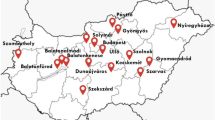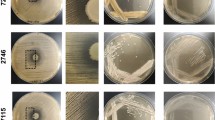Abstract
To investigate the mechanism of action by which farnesol functions as an antibacterial agent and inhibits Staphylococcus aureus growth, the growth rates of S. aureus cultured in farnesol versus S. aureus cultured in farnesol and supplemented with 3-hydroxy-3-methylglutaryl (HMG)-CoA or mevalonate were compared. The investigation was designed to observe whether farnesol affected on the mevalonate pathway by using the intermediate metabolites of the pathway. The resulting growth curves demonstrated that mevalonate reduced the antibacterial activity of farnesol, but HMG-CoA did not inhibit farnesol. These results suggest that farnesol affects the mevalonate pathway. Moreover, farnesol inhibited HMG-CoA reductase activity in an in vitro enzymatic assay.
Similar content being viewed by others
Log in or create a free account to read this content
Gain free access to this article, as well as selected content from this journal and more on nature.com
or
References
Hada, T. et al. Inhibitory effects of terpenes on the growth of Staphylococcus aureus. Nat. Med. 57, 64–67 (2003).
Inoue, Y. et al. Biphasic effects of geranylgeraniol, teprenone and phytol on the growth of Staphylococcus aureus. Antimicrob. Agents Chemother. 49, 1770–1774 (2005).
Togashi, N., Hamashima, H., Shiraishi, A., Inoue, Y. & Takano, A. Antibacterial activity against Staphylococcus aureus of terpene alcohols with aliphatic carbon chains. J. Essent. Oil Res. 22, 263–269 (2010).
Inoue, Y. et al. The antibacterial activity of terpene alcohols on Staphylococcus aureus and their mode of action. FEMS Microbiol. Lett. 237, 325–331 (2004).
Togashi, N., Inoue, Y., Hamashima, H. & Takano, A. Effect of two terpene alcohols on the antibacterial activity and the mode of action of farnesol against Staphylococcus aureus. Molecules 13, 3069–3076 (2008).
Correll, C. C., Ng, L. & Edwards, P. A. Identification of farnesol as the non-sterol derivative of mevalonic acid required for the accelerated degradation of 3-hydroxy-3-methylglytaryl-coenzyme A reductase. J. Biol. Chem. 269, 17390–17393 (1994).
Meigs, T. E., Roseman, D. S. & Simoni, R. D. Regulation of 3-hydroxy-3-methylglutaryl-coenzyme A reductase degradation by the nonsterol mevalonate metabolite farnesol in vivo. J. Biol. Chem. 271, 7919–7922 (1996).
Miquel, K., Pradines, A., Terce, F., Selmi, S. & Favre, G. Competitive inhibition of choline phosphotransferase by geranylgeraniol and farnesol inhibits phosphatidylcholine synthesis and induces apoptosis in human lung adenocarcinoma A549 cells. J. Biol. Chem. 273, 26179–26186 (1998).
Flach, J., Antoni, I., Villemin, P., Bentzen, C. L. & Niesor, E. J. The mevalonate/isoprenoid pathway inhibitor Apomin (SR-45023A) is antiproliferative and induces apoptosis similar to farnesol. Biochem. Biophys. Res. Comm. 270, 240–246 (2000).
Arai, T., Hamashima, H. & Sasatsu, M. Inhibitory effects of fatty acids, purified camellia oil and olive oil on the growth of Staphylococcus aureus. Jpn. J. Chemother. 44, 786–791 (1996).
Matsumoto, Y., Hamashima, H., Shiojima, K., Sasatsu, M. & Arai, T. The antibacterial activity of plaunotol against Staphylococcus aureus isolated from the skin of patients with atopic dermatitis. Microbios 96, 149–155 (1998).
Wilding, E. I. et al. Essentiality, expression, and characterization of the class II 3-hydroxy-3-emthylglutaryl coenzyme A reductase of Staphylococcus aureus. J. Bacteriol. 182, 5147–5152 (2000).
Bradford, M. M. A rapid and sensitive method for the quantitation of microgram quantities of protein utilizing the principle of protein-dye binding. Anal. Biochem. 72, 248–254 (1976).
Hedl, M., Tabernero, L., Stauffacher, C. V. & Rodwell, V. W. Class II 3-hydroxy-3-methylglutaryl coenzyme A reductases. J. Bacteriol. 186, 1927–1932 (2004).
Acknowledgements
We thank Satomi Kaneko and Misaki Ohashi for useful suggestions on the HMG-CoA reductase activity assay.
Author information
Authors and Affiliations
Corresponding author
Ethics declarations
Competing interests
The authors declare no conflict of interest.
Rights and permissions
About this article
Cite this article
Kaneko, M., Togashi, N., Hamashima, H. et al. Effect of farnesol on mevalonate pathway of Staphylococcus aureus. J Antibiot 64, 547–549 (2011). https://doi.org/10.1038/ja.2011.49
Received:
Revised:
Accepted:
Published:
Issue date:
DOI: https://doi.org/10.1038/ja.2011.49
Keywords
This article is cited by
-
In vitro bioactivities and gastrointestinal simulation validate ethnomedicinal efficacy of five fermented kodo-based Himalayan traditional drinks and bioaccessibility of bioactive components
Food Production, Processing and Nutrition (2024)
-
Evaluation of farnesol-induced changes in the haemocyte pattern of red cotton bug Dysdercus koenigii Fabricius (Heteroptera: Pyrrhocoridae)
The Journal of Basic and Applied Zoology (2022)
-
A critical role of mevalonate for peptidoglycan synthesis in Staphylococcus aureus
Scientific Reports (2016)
-
Confocal laser scanning microscopy analysis of S. epidermidis biofilms exposed to farnesol, vancomycin and rifampicin
BMC Research Notes (2012)



